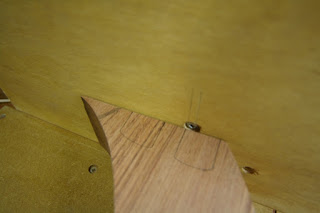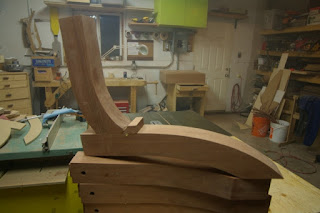So because this table expands and contracts to different diameters there is a perimeter ring added which raises in and out of position. The ring performs a couple of functions. The first is that when the table is small it allows the table to remain circular, otherwise the panels which are circular when large would create a slightly lobate perimeter. The second function is concealing the mechanisms that allow for the expansion and contraction to occur. The perimeter is 5 1/4 inches tall which keeps the mechanisms concealed when small, and when large the ring drops down to allow the expansion and continues to conceal the mechanisms.
The most time consuming part of the ring components is the bent lamination. I know that some people build bending forms with a curve which is tighter than desired to allow for the springback that often results from quickly cycling parts through the bending form. The way I was taught and have experimented a little as well eliminates this. I have found that by building my bending forms to the exact curve I need and keeping the parts in the form longer the spring back is eliminated. If we leave a blob of glue on a table and poke it in an hour there will be a skin on the surface but it will still be mushy inside, come back in half a day and it is harder but still soft, but if you come back in a day it will likely be hard, only moved with a chisel. Using this logic I leave my laminations in their bending forms for two days. This way, the parts don't move at all after removal and they are all identical. As a result of the two day time frame, and there being six components I knew it would take 12 days to work through all these parts. A good part to start at the beginning of the project.
The process started with resawing a pile of 1/8" thick by 4" wide strips, each lamination is made up of 8 laminae to come out to a full 1" thick when completed.
 |
| Stock for Bent Lamination |
The bending form is made up of 9 layers of 1/2" MDF. The first is faired to the exact curve desired, the rest are added two at a time and then pattern matched to the first. Also, a shelf was added to the bottom of the form to provide a reference surface for the bottom edge of the lamination.
 |
| Bending Form for the Bent Lamination |
Thank goodness my friends Aric and Dave showed me the benefit of applying glue using a paint roller. I can't imagine any better way to apply glue evenly to large surfaces quickly. Once the glue is ready the laminations are clamped in the form. Clamp blocks with a concave face are used to distribute pressure better. A flat surface would only apply pressure on the tangent of the curve, but by having a concave surface (even if the curve is greater than that which it mates with) each block has two contact points rather than one. Even with the blocks to spread out the pressure it takes many many clamps to put the laminations in the forms.
 |
| Gluing up the Laminae |
 |
| Clamp Blocks to Distribute Pressure |
 |
| Formed up and Ready for the Wait |
Once the laminations are completed they are edge jointed and then ripped true on the table saw. The first component is now completed.
 |
| Trimming the Edges of the Laminations |
The second half of the perimeter section forms the top portion. It is a curved section as well but the curves are not parallel so it is not as conducive to being built as a lamination. I built it out of solid stock 2" thick. The pieces were cut slightly oversize on the bandsaw and then pattern routed to match. The tricks I have come to rely on for pattern routing include using 3 screws for reference points to ensure consistency, using some double sided tape and sand paper to help keep the pieces in place, and the change to using the newer Bessey auto adjusting toggle clamps. Other than that I just like to try and use the two sides of a peice of MDF so that I don't mix things up and have fewer jigs and forms piling up.
 |
| Pattern Matching the Top Components |
Once the pieces are all routed identically, a recess needs to be routed to one inch from the top surface for the mounting bracket to attach to. Also, there is a 1/8" thick strip glued onto the inside of the curve one inch down fromthe top surface. This is only being added as a reveal to keep people from seeing through the thin gap between the ring and the panels.
 |
| Routing out the Mounting Bracket Recess |
 |
| Gluing on the Reveal Strip |
Now that the top component is completed the two parts can be joined together. A set of 1/4" holes are drilled in one half of the pair and then a set of center finders are used to transfer the location to the other half. Once the second half of the holes is drilled 1/4" dowels are used in to align the parts during glue up.
 |
| Aligning the two Parts of the Curve with 1/4" Center Finding Pins and Dowels |
 |
| All Six of the Perimeter Sections Glued Up |
Once the glue is set it is time to clean up the surfaces. Resulting from there being two components coming together there is a glue line about one third of the way down from the top surface. To hide this and to provide nice continuous grain around the perimeter the outer face of the curve was cleaned up so that it can have a skin of quarter sawn wood can be applied to it.
 |
| Fairing the Outer Surface for the Addition of the Skin |
 |
| Gluing up the Quarter Sawn Skin |
 |
| Clamp Blocks and Blue Foam for Even Pressure |
Once the skin has been applied to the perimeter section I was finallly done building the piece. The piece was ripped to a final width of 5 and 1/4" and each end is trimmed and mortised. This trim cut is one of the more stressful cuts in the whole process because it is done 12 times, creating 6 sequential joints. Any errors in the angle of the cut and the subsequent mortise which needs to be square to the cut will only be compounded as the pieces are assembled. Below is the jig I used to hold the piece while trimming, it is just a sled with support block and toggle clamp. Once the trim cut is made I left the piece in the sled and brought a Festool Domino to the work so that it is done while the face of the joint is still square to the table.
 |
| Trim Cutting the Ends of the Perimeter Sections |
 |
| Using a Festool Domino to Mortise the Perimeter Sections |
 |
| Floating Tenons Used in the Perimeter |
Seeing the ring come together with very minimal tweaking required to the joints was fantastic to see. The critical measurement out of all this was the distance from the inside corner of a joint to the inside corner of the opposite joint. I was shooting for a measurement of 64 5/8". Imagine my excitement when I hit all three of these within 1/32".
 |
| Gluing up the Parts to Make the Ring |
 |
| Nailed It! |


























































